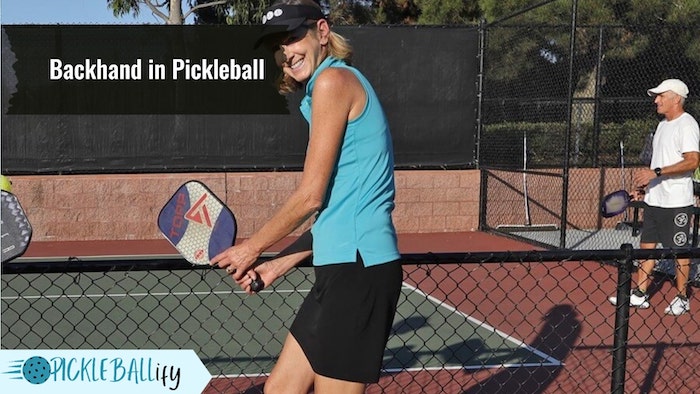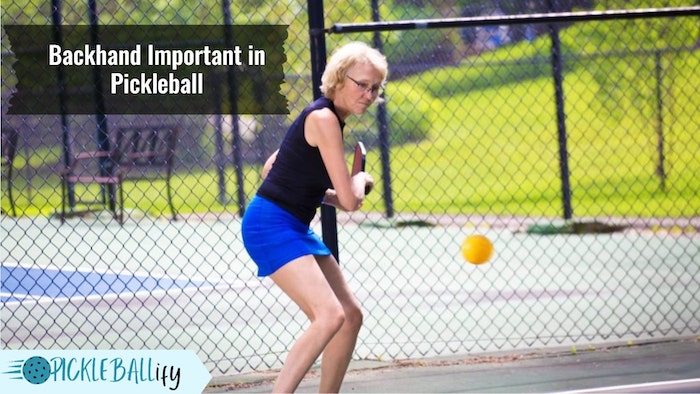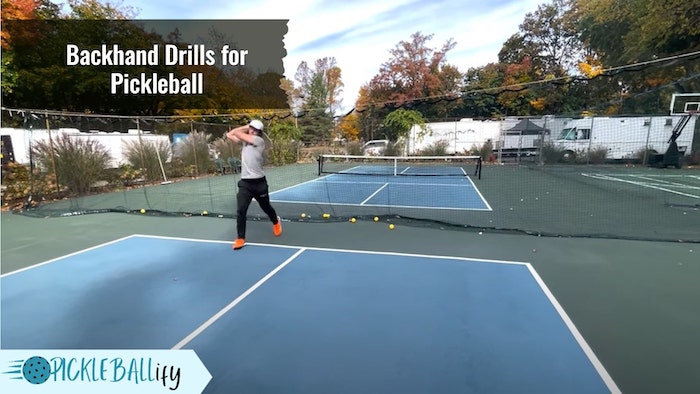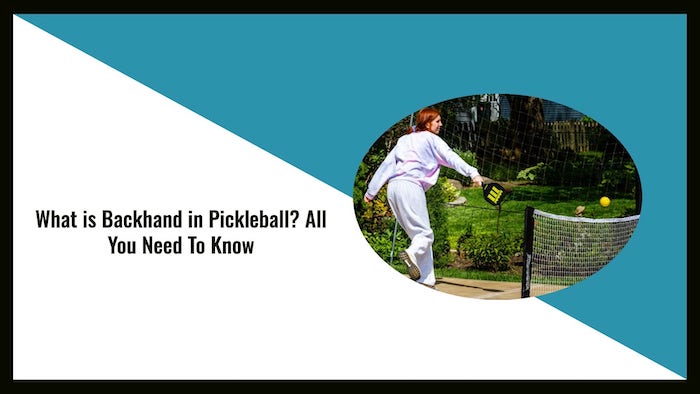If you’ve never played pickleball before, the term “backhand” may sound intimidating. But fear not! The backhand shot is an essential skill that every player should master in order to excel on the court. Whether you’re a beginner or a seasoned player looking to improve your game, our guide will give you everything you need to know about backhands in pickleball.
From techniques and drills to common mistakes, we’ve got you covered. So grab your paddle and let’s dive into unraveling the mysteries of the backhand roll swing!
What is Backhand in Pickleball?
In pickleball, the backhand shot is when a player hits the ball with their paddle on their non-dominant side. For right-handed players, this means hitting the ball on the left side of their body, and vice versa for lefties.

The backhand shot can be more challenging for some players since it requires more wrist action and accuracy than a forehand shot. However, mastering your backhand technique will open up new possibilities in your game, allowing you to hit shots from different angles and positions that could otherwise be impossible.
It’s important to note that there are different types of backhands in pickleball such as top spin, slice, or block depending on how you want to play the ball. Each type has its own unique advantages depending on your opponent’s position on the court.
Learning how to do a proper backhand shot takes time and practice but can make all the difference in winning points during games.
How to do a Backhand in Pickleball
To execute a backhand shot in pickleball, you need to have proper grip and footwork. Firstly, hold the paddle with your non-dominant hand at the base of the handle while placing your dominant hand on top of it. The V-shaped area between your thumb and index finger should be placed on the paddle’s face.
The Backhand Roll is a powerful shot that every pickleball player needs to have in their arsenal. It’s a shot that requires proper grip, stance, footwork, and spin. In this guide, we’ll go over everything you need to know to master the backhand roll and take your game to the next level.
Gripping the Paddle: Finding the Right Fit
One of the most critical aspects of the backhand roll is the grip. Finding the right one can make all the difference. While the pros can easily switch between grips, for the everyday rec player, it’s not always the easiest task.
The Eastern grip is a popular choice for a backhand roll, but the Continental grip may be more comfortable for some players. Experiment with different grips to find what works best for you.
Stance and Body Positioning
To execute the backhand roll effectively, you’ll need to be in the right stance and body position. This includes standing with your feet shoulder-width apart, knees slightly bent, and your weight centered between your feet but not beyond the balls of your feet.
An affixed split step will help keep you agile and balanced, and a slightly deeper bend at the knees will enable you to move from low to high quickly.
Proper Footwork
Footwork for the backhand roll is constrained due to the kitchen line, but adjusting the width of your feet for the point of contact with the ball can make all the difference.
Widening your stance as the ball leaves your opponent’s paddle will make it easier to get lower to meet the ball and give you the right angle for your shot.
Understanding Spin
Topspin is essential for the backhand roll. Without it, the ball will most likely pop up or drive into the net. To create the perfect topspin, your swing angle should be close to 45 degrees, while your paddle remains parallel to the net. Propelling your arm forward at 45 degrees while keeping your paddle face completely vertical will give you the spin you need to execute the perfect backhand roll.
In conclusion, the backhand roll is a powerful and effective shot that can help take your pickleball game to the next level. By following these tips and techniques, you’ll be well on your way to mastering this shot and dominating the court.
Why a Backhand is Important in Pickleball
The backhand shot is an essential part of any pickleball player’s arsenal. It allows you to hit the ball on your non-dominant side with accuracy and power, which can be a game-changer in many situations.
If you want to improve your backhand then you can check this video on YouTube.
- One reason why the backhand is so important in pickleball is that it gives you more options on the court. If all you have is a forehand, then your opponent knows where to place the ball, making it easier for them to anticipate and return your shots.
- However, with a solid backhand in your repertoire, you can surprise your opponent by hitting shots they weren’t expecting from that side of the court.

- Another advantage of having a good backhand in pickleball is that it helps you maintain balance and control during rallies. When playing at high speeds, being able to switch between forehands and backhands seamlessly allows players to keep their body weight centered and avoid awkward movements which can lead to unforced errors.
- Additionally, mastering this shot will help prevent injuries caused by overuse or fatigue as relying solely on one technique may put undue strain on certain muscles leading up to chronic problems such as tennis elbow or rotator cuff issues.
- In summary, having a strong backhand shot not only expands strategic choices but enhances overall gameplay while reducing the risk of injury thereby improving chances for success as well.
Is the Backhand Roll More Shoulder or Wrist?
Have you ever wondered what makes the backhand roll such an effective shot in pickleball? Many players mistakenly believe that it’s all about the wrist action, but the truth is more subtle. To achieve a strong backhand roll, you need to focus on the movement of your shoulder and arm, not just your wrist.
Generating Power From the Shoulder
While the wrist certainly plays a role in the shot, the primary source of power comes from your shoulder and arm. To achieve a strong backhand roll, you need to crouch low, extend your arm fully, and rotate your lower arm at the elbow.
Although it may look like a simple flick of the wrist, your wrist should remain parallel to your lower arm throughout the swing.
Tucking Your Arm for Maximum Momentum
The position of your arm is also essential for generating power on the backhand roll. By tucking your arm close to your body, you can create a longer swing arc and generate more momentum. This will allow you to hit the ball with greater speed and precision, making it more difficult for your opponent to return.
Smooth and Timely Swing
In pickleball, timing is everything, and the backhand roll is no exception. To execute the shot properly, start with a low view and swing smoothly.
Your swing should begin low and end with your arm fully grown when it makes contact with the ball. It may take some time to perfect the timing, but with enough training, you’ll be able to master this powerful shot.
Backhand Drills for Pickleball
Backhand drills are an essential part of improving your pickleball game. These drills help you develop a solid backhand shot which is critical for playing at the highest level. Here are some simple yet effective backhand drills that will help you improve your skills.
- The first drill is called “shadowing”. Stand in front of a wall or mirror with your paddle and practice hitting imaginary balls with your backhand. This exercise helps to improve muscle memory, footwork, and hand-eye coordination.
- Another great drill is the “half-volley” drill, where you hit low balls just after they bounce off the ground. This drill improves reflexes and hand strength required for quick shots on the court.

- The third one is called “cross-court dinks”, where two players stand diagonally opposite each other on either side of the net and take turns hitting soft shots toward each other’s backhands. This drill improves accuracy and control as it focuses on hitting precise shots rather than powerful ones.
- Try practicing “backhand lobs” to improve shot variety during gameplay. Hit high arcing shots over opponents’ heads using minimal force from their backhands
Incorporating these drills into your training routine can dramatically enhance your skillset while boosting confidence levels on the court!
Common Mistakes to Avoid while Hitting Backhand Shot
- Hitting a backhand shot in pickleball can be challenging, but it is an essential skill to master. However, due to its complexity, it is not uncommon for players to make mistakes while hitting their backhand shots. Here are some common mistakes that players should avoid while hitting a backhand shot.
- Firstly, one of the most common mistakes that players make is using too much wrist in their swing. This not only reduces power and accuracy but also increases the risk of injury. It’s best to keep your wrist firm and rely on your arm muscles for power.

- Another mistake commonly made by beginners is standing too far from the ball when preparing for a backhand shot. This results in poor timing and weak contact with the ball. Players should always position themselves close enough to strike the ball at waist height comfortably.
- Players may also tend to open up their shoulders too early during the swing which leads them off-balance resulting in weaker hits or missed shots altogether. A good way to fix this issue would be to keep your shoulder closed until they naturally turn while completing your follow-through.
- Another common mistake when executing a backhand shot would be focusing solely on power instead of technique leading you out of court or losing points because of errors such as crossing over into a non-volley zone (NVZ). Always prioritize proper form over force.
- By avoiding these common mistakes, players can improve their performance and have better control over their game plan during matches than ever before.
FAQs
One common mistake is not positioning their body correctly, which can affect their balance and power. Another mistake is not following through with their shot, which can result in a weaker hit. Not using the proper grip or failing to adjust their grip for different shots is also a mistake that can affect accuracy and power.
The ideal height for a backhand shot in pickleball is generally waist-height or lower. Hitting the ball at this height will give you more control over the shot and make it more difficult for your opponent to return. However, the ideal height may vary depending on your playing style and the situation on the court.
Footwork is crucial for hitting effective backhand shots in pickleball. Proper footwork helps you get into the right position to make the shot and maintain balance and control. It’s important to position yourself correctly and be ready to move quickly to adjust to the ball’s trajectory.
To improve your backhand shot in pickleball, practice your footwork and positioning, work on developing a consistent swing motion, and focus on keeping your wrist firm and stable during the shot. It can also be helpful to work with a coach or more experienced player to receive feedback and guidance.
The backhand shot in pickleball is executed on the non-dominant side of the player’s body, while the forehand shot is executed on the dominant side. The swing motion and paddle positioning also differ between the two shots.
Final Thoughts
To sum up, the backhand shot is an essential part of pickleball gameplay that can make or break your performance on the court. With practice and patience, you can master this skill and become a formidable opponent.
Remember to keep your wrist firm and use proper footwork when executing the backhand shot. Incorporate drills into your training routine to improve your speed, accuracy, and power.
Most importantly, don’t forget to have fun! Pickleball is a social sport that brings people together for friendly competition and good times. By improving your backhand shot, you’ll be able to enjoy the game more fully while also honing your skills as a player.
So go out there with confidence in your newly acquired knowledge of what a backhand is in pickleball! Happy playing!

